NVIDIA's GeForce GTX 560 Ti: Upsetting The $250 Market
by Ryan Smith on January 25, 2011 9:00 AM ESTCompute & Tessellation
Moving on from our look at gaming performance, we have our customary look at compute performance, bundled with a look at theoretical tessellation performance. Unlike our gaming benchmarks where NVIDIA’s architectural differences between GF114 and GF110 are largely irrelevant, they can become much more important under a compute-bound situation depending on just how much ILP can be extracted for the GTX 560 Ti.
Our first compute benchmark comes from Civilization V, which uses DirectCompute to decompress textures on the fly. Civ V includes a sub-benchmark that exclusively tests the speed of their texture decompression algorithm by repeatedly decompressing the textures required for one of the game’s leader scenes.
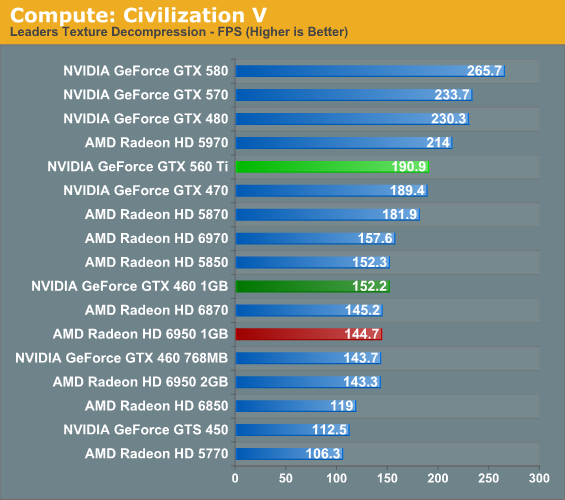
Under our Civilization 5 compute benchmark we have a couple of different things going on even when we just look at the NVIDIA cards. Compared to the GTX 460 1GB, the GTX 560 enjoys a 31% performance advantage; this is less than the theoretical maximum of 39%, but not far off from the performance advantages we’ve seen in most games. Meanwhile the GTX 470 is practically tied with the GTX 560 even though on paper the GTX 560 has around a 15% theoretical performance advantage. This ends up being a solid case of where the limitations of ILP come in to play, as clearly the GTX 560 isn’t maximizing the use of its superscalar shaders. Or to put it another way, it’s an example as to why NVIDIA isn’t using a superscalar design on their Tesla products.
Meanwhile this benchmark has always favored NVIDIA’s architectures, so in comparison to AMD’s cards there’s little to be surprised about. The GTX 560 Ti is well in the lead, with the only AMD card it can’t pass being the dual-GPU 5970.
Our second GPU compute benchmark is SmallLuxGPU, the GPU ray tracing branch of the open source LuxRender renderer. While it’s still in beta, SmallLuxGPU recently hit a milestone by implementing a complete ray tracing engine in OpenCL, allowing them to fully offload the process to the GPU. It’s this ray tracing engine we’re testing.
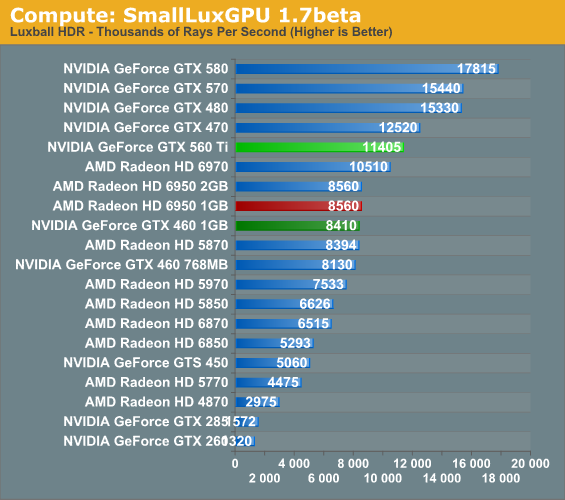
Small Lux GPU is the other test in our suite where NVIDIA’s drivers significantly revised our numbers. Where this test previously favored raw theoretical performance, giving the vector-based Radeons an advantage, NVIDIA has now shot well ahead. Given the rough state of both AMD and NVIDIA’s OpenCL drivers, we’re attributing this to bug fixes or possibly enhancements in NVIDIA’s OpenCL driver, with the former seeming particularly likely. However NVIDIA is not alone when it comes to driver fixes, and AMD has seem a similar uptick against the newly released 6900 series. It’s not nearly the leap NVIDIA saw, but it’s good for around 25%-30% more rays/second under SLG. This appears to be accountable to further refinement of AMD’s VLIW4 shader compiler, which as we have previously mentioned stands to gain a good deal of performance as AMD works on optimizing it.
So where does SLG stack up after the latest driver enhancements? With NVIDIA’s rocket to the top, they’re now easily dominating this benchmark. The GTX 560 Ti is now slightly ahead of the 6970, never mind the 6950 1GB where it has a 33% lead. Rather than being a benchmark that showed the advantage of having lots of theoretical compute performance, this is now a benchmark that seems to favor NVIDIA’s compute-inspired architecture.
Our final compute benchmark is a Folding @ Home benchmark. Given NVIDIA’s focus on compute for Fermi, cards such as the GTX 560 Ti can be particularly interesting for distributed computing enthusiasts, who are usually looking for a compute card first and a gaming card second.
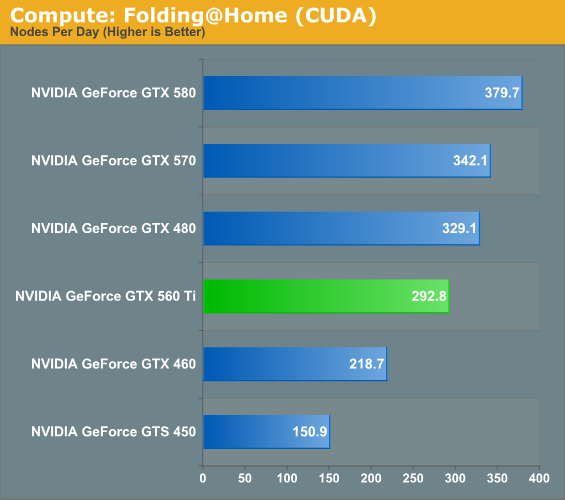
Against the senior members of the GTX 500 series and even the GTX 480 the GTX 560 Ti is still well behind, but at the same time Folding @ Home does not look like it significantly penalizes GTX 560’s superscalar architecture.
At the other end of the spectrum from GPU computing performance is GPU tessellation performance, used exclusively for graphical purposes. With Fermi NVIDIA bet heavily on tessellation, and as a result they do very well at very high tessellation factors. With 2 GPCs the GTX 560 Ti can retire 2 triangles/clock, the same rate as the Radeon HD 6900 series, so this should be a good opportunity to look at theoretical architectural performance versus actual performance.
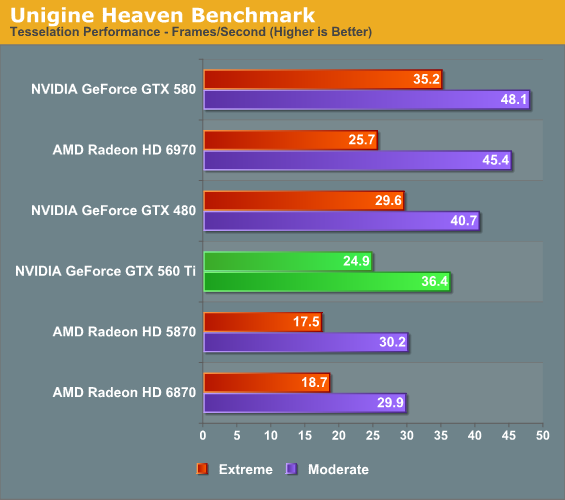
Against the AMD 5800 and 6800 series, the GTX 560 enjoys a solid advantage, as it’s able to retire twice as many triangles per clock as either architecture. And while it falls to both GTX 480 and GTX 580, the otherwise faster Radeon HD 6970 is close at times – at moderate tessellation it has quite the lead, but the two are neck-and-neck at extreme tessellation where triangle throughput and the ability to efficiently handle high tessellation factors counts for everything. Though since Heaven is a synthetic benchmark at the moment (the DX11 engine isn’t currently used in any games) we’re less concerned with performance relative to AMD’s cards and more concerned with performance relative to the other NVIDIA cards.
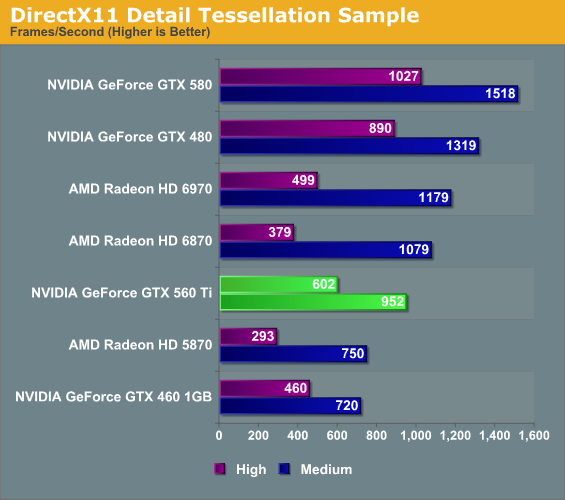
Microsoft’s Detail Tessellation sample program showcases NVIDIA’s bet on tessellation performance even more clearly. NVIDIA needs very high tessellation factors to shine compared to AMD’s cards. Meanwhile against the GTX 460 1GB our gains are a bit more muted; even though this is almost strictly a theoretical test, the GTX 560 only gains 30% on the GTX 460. Ultimately while the additional SM unlocks another tessellator on NVIDIA’s hardware, it does not unlock a higher triangle throughput rate, which is dictated by the GPCs.










87 Comments
View All Comments
auhgnist - Tuesday, January 25, 2011 - link
1920x1080 graph is wrong, should be mistakenly used that of 2560x1600Ryan Smith - Tuesday, January 25, 2011 - link
Fixed. Thanks.Marlin1975 - Tuesday, January 25, 2011 - link
6950 1gig look good.I am guessing the 560 will either drop in price very quickly or the 6950 will sell better.
Lolimaster - Tuesday, January 25, 2011 - link
Not impressive at alla the 560, 6950 1GB is a good value over the 2GB 6950. I think if you just prefer 1GB 6870 offers more bang for buck.cactusdog - Tuesday, January 25, 2011 - link
Wow, plenty of good options from AMD and Nvidia. Since the introduction of eyefinity and 3D surround, we dont need to spend a fortune to play the latest games. For most users with 1 monitor a $250 dollar card gives excellent performance.tech6 - Tuesday, January 25, 2011 - link
Like top end desktop CPUs, the high end GPU really seems to be increasingly irrelevant for most gamers as the mid-range provides plenty of performance for a fraction of the cost.Nimiz99 - Tuesday, January 25, 2011 - link
I was just curious about the 2.8 FPS on Crysis by the Radeon HD 5970 - is that reproducible/consistent?I am just curious, b/c on the first graph of average frame-rate it leads the pack; if it fluctuates that badly I would definitely like a little bit more background on it.
'Preciate the response,
Nimiz
Ryan Smith - Tuesday, January 25, 2011 - link
No, it's highly variable. With only 1GB of effective VRAM, the Radeon cards are forced to texture swap - the minimum framerate is chaotic at best and generally marks how long the worst texture swap took. With swapping under the control of AMD's drivers, the resulting minimum framerate ends up being quite variable.Shadowmaster625 - Tuesday, January 25, 2011 - link
Can somebody explain why 1GB is not enough when 1GB is enough memory to store over 160 frames at 24 bits at 1920x1080. At 60fps, 1GB should be able to supply a constant uncompressed stream of frames for almost 3 whole seconds. Seems like more than enough memory to me. Sounds like somebody is just haphazardly wasting vast amounts of space for no reason at all. Sort of like windows with its WinSXS folder. Lets just waste a bunch of space because we can!ciukacz - Tuesday, January 25, 2011 - link
are you streaming your benchmark video through youtube ?because i am rendering mine realtime, which requires loading all the textures, geometry etc.